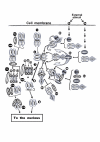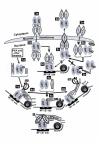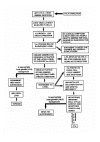Role of Tax protein in human T-cell leukemia virus type-I leukemogenicity
- PMID: 15310405
- PMCID: PMC514576
- DOI: 10.1186/1742-4690-1-20
Role of Tax protein in human T-cell leukemia virus type-I leukemogenicity
Abstract
HTLV-1 is the etiological agent of adult T-cell leukemia (ATL), the neurological syndrome TSP/HAM and certain other clinical disorders. The viral Tax protein is considered to play a central role in the process leading to ATL. Tax modulates the expression of many viral and cellular genes through the CREB/ATF-, SRF- and NF-kappaB-associated pathways. In addition, Tax employs the CBP/p300 and p/CAF co-activators for implementing the full transcriptional activation competence of each of these pathways. Tax also affects the function of various other regulatory proteins by direct protein-protein interaction. Through these activities Tax sets the infected T-cells into continuous uncontrolled replication and destabilizes their genome by interfering with the function of telomerase and topoisomerase-I and by inhibiting DNA repair. Furthermore, Tax prevents cell cycle arrest and apoptosis that would otherwise be induced by the unrepaired DNA damage and enables, thereby, accumulation of mutations that can contribute to the leukemogenic process. Together, these capacities render Tax highly oncogenic as reflected by its ability to transform rodent fibroblasts and primary human T-cells and to induce tumors in transgenic mice. In this article we discuss these effects of Tax and their apparent contribution to the HTLV-1 associated leukemogenic process. Notably, however, shortly after infection the virus enters into a latent state, in which viral gene expression is low in most of the HTLV-1 carriers' infected T-cells and so is the level of Tax protein, although rare infected cells may still display high viral RNA. This low Tax level is evidently insufficient for exerting its multiple oncogenic effects. Therefore, we propose that the latent virus must be activated, at least temporarily, in order to elevate Tax to its effective level and that during this transient activation state the infected cells may acquire some oncogenic mutations which can enable them to further progress towards ATL even if the activated virus is re-suppressed after a while. We conclude this review by outlining an hypothetical flow of events from the initial virus infection up to the ultimate ATL development and comment on the risk factors leading to ATL development in some people and to TSP/HAM in others.
Figures






References
-
- Richardson JH, Hollsberg P, Windhagen A, Child LA, Hafler DA, Lever AML. Variable immortalizing potential and frequent virus latency in blood-derived T-cell clones infected with human T-cell leukemia virus type I. Blood. 1997;89:3303–3314. - PubMed
Publication types
MeSH terms
Substances
LinkOut - more resources
Full Text Sources
Other Literature Sources
Miscellaneous

